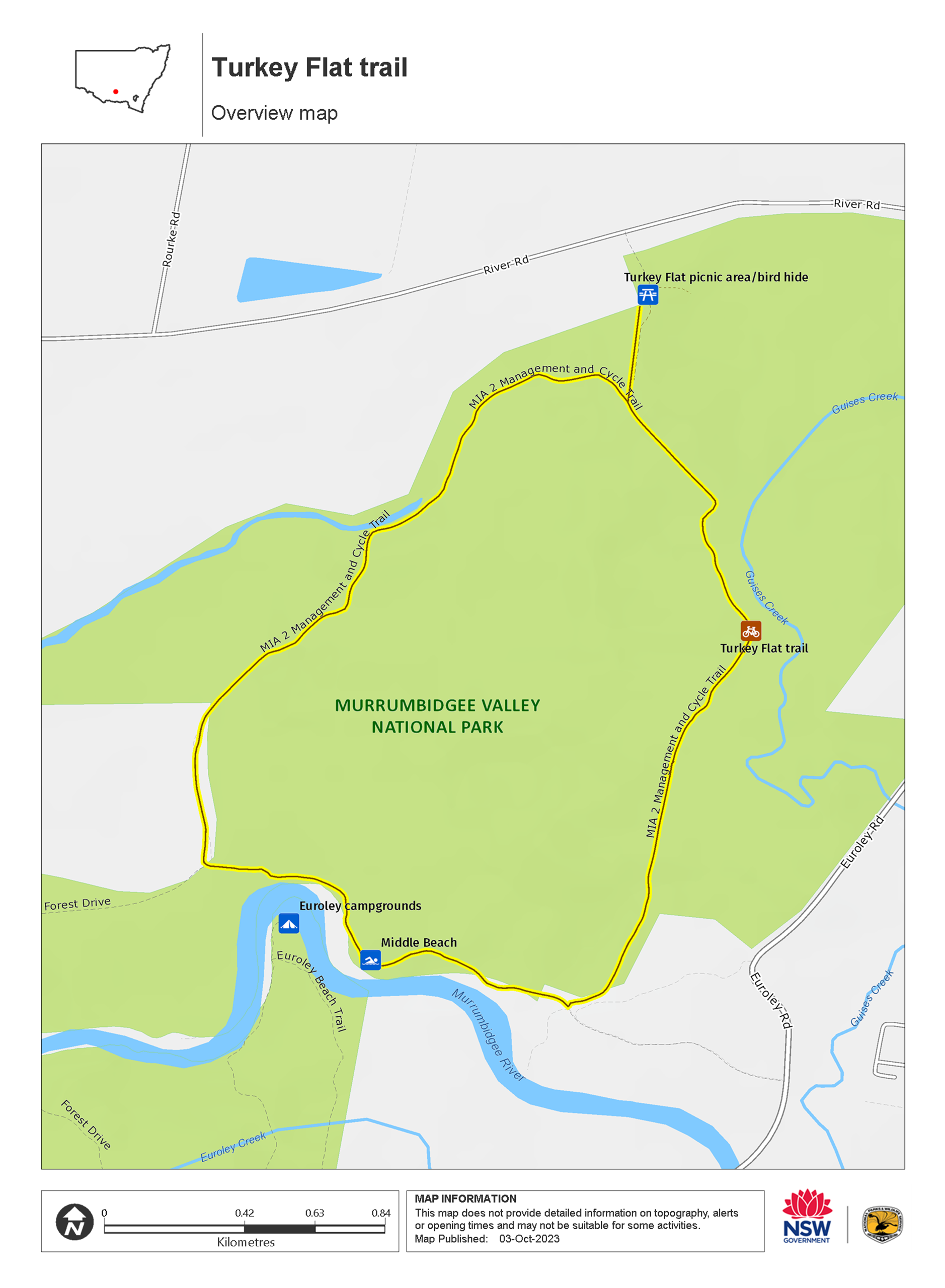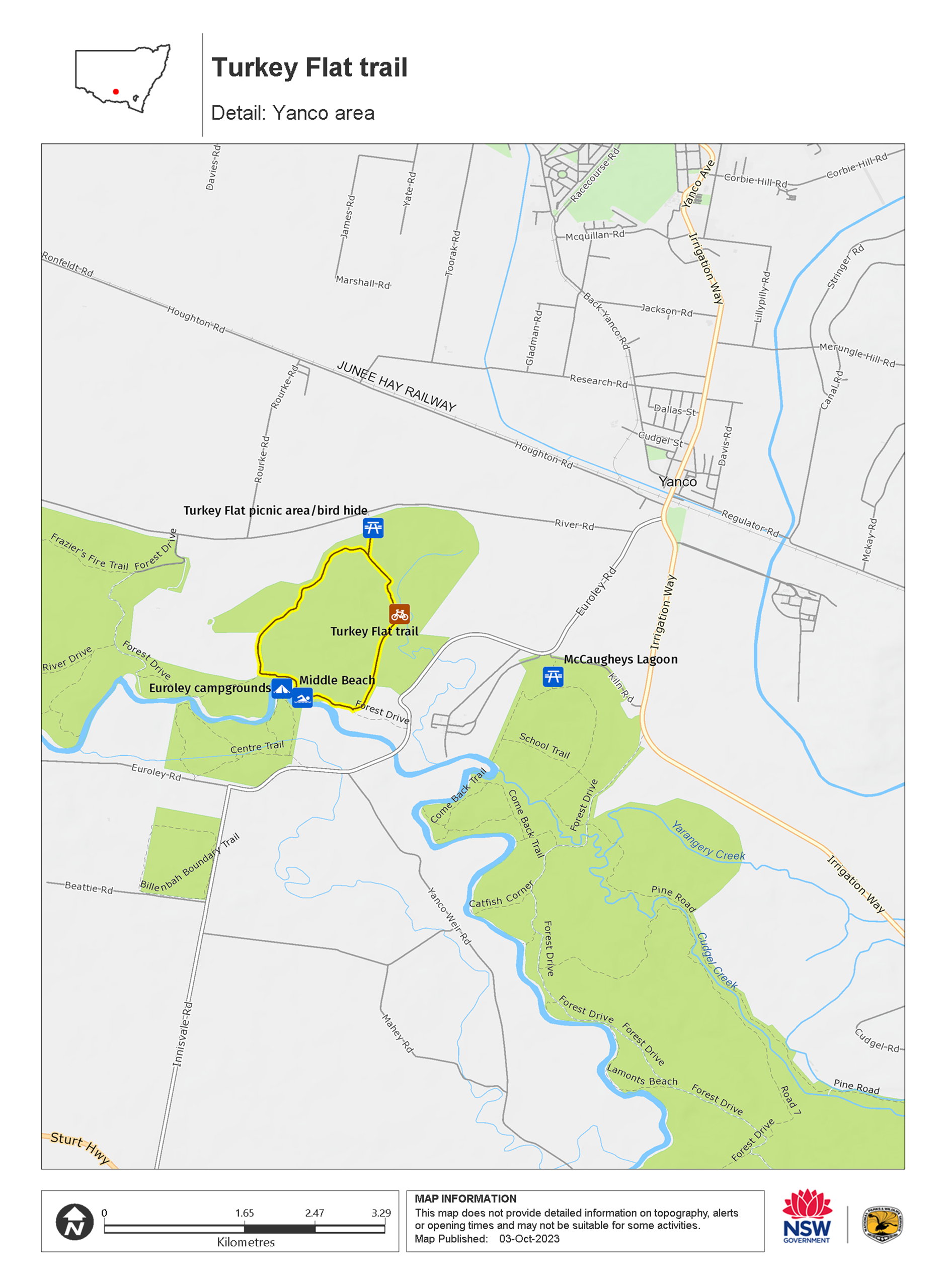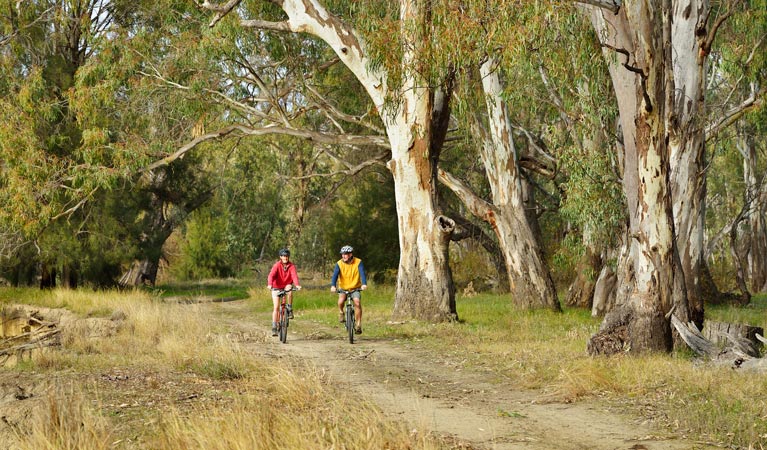Turkey Flat trail
Murrumbidgee Valley National Park
Overview
Visit Murrumbidgee Valley National Park, near Leeton, to combine birdwatching, bushwalking and mountain biking. This great trail ends at Middle Beach.
- Accessibility
- Hard
- Distance
- 3.2km one-way
- Time suggested
- 1hr 30min
- Opening times
- Turkey Flat trail is always open, but may have to close at times due to poor weather or fire danger.
- What to
bring - Hat, drinking water, sunscreen
- Please note
- This trail can also be completed in the opposite direction by starting at Middle Beach and heading up to Turkey Flat Wetland
- There is limited mobile reception in this park
- The weather in this area can be extreme and unpredictable, so please ensure you’re well-prepared for your visit.
- Remember to take your binoculars if you want to go birdwatching
Turkey Flat trail is the ultimate twitchers’ trail, taking you through the habitats of countless woodland and wetland birds.
The trail begins at Turkey Flat wetlands, close to Leeton. Start with a little birdwatching at the bird hide and then, when you’re ready to get going, take the flat track over the floodwater regulator, which offers a great vantage point for seeing ducks flying overhead.
Keep your eyes peeled as you’re hiking or mountain biking. You might glimpse threatened superb parrots, white-bellied sea eagles and sacred kingfishers, as well as other varieties too numerous to name. You’ll probably spot the odd kangaroo, too, and be serenaded by frogs, particularly after rain.
When you reach the junction, turn left or right – your choice – and follow the track as it meanders through part of the world’s largest protected area of river red gum forest.
You’ll end up at Middle Beach, which is a great spot to cool off with a swim or picnic. Alternatively, continue the birdwatching theme and watch pelicans skidding in to land on the water.
Map

Map

Map legend

Local alerts
For the latest updates on fires, closures and other alerts in this area, see https://www.nationalparks.nsw.gov.au/things-to-do/cycling-trails/turkey-flat-trail/local-alerts
General enquiries
- National Parks Contact Centre
- 7am to 7pm daily
- 1300 072 757 (13000 PARKS) for the cost of a local call within Australia excluding mobiles
- parks.info@environment.nsw.gov.au
Park info
- in Murrumbidgee Valley National Park in the Murray-Riverina region
Murrumbidgee Valley National Park is always open but may have to close at times due to poor weather or fire danger.
Visitor info
All the practical information you need to know about Turkey Flat trail.
Maps and downloads
Learn more
Turkey Flat trail is in Murrumbidgee Valley National Park. Here are just some of the reasons why this park is special:
River redgum

Murrumbidgee Valley National Park is synonymous with Riverina river redgum forests – an iconic Australian eucalypt which grows to awe-inspiring heights. With a deep red colour curving along rivers and channels, Riverina river red gum is of international significance. These special eucalypts provide a home to koalas, which you may spot in their branches. Bird watchers might catch a glimpse of white-bellied sea eagles, sacred kingfishers, and threatened superb parrots, amid the majestic trees. There are plenty of fishing opportunities available in the park too, with yellow belly, redfin and brim fish to catch in the area. Murrumbidgee Valley is also a sanctuary for reptiles and kangaroos.
- Forest drive If you’re looking for a scenic day trip near Murrumbidgee River, near Narrandera, go 4WDing or mountain biking along Forest drive, in Murrumbidgee Valley National Park.
- Turkey Flat picnic area and bird hide Set on Murrumbidgee River, Turkey Flat picnic area and bird hide is a great picnic spot. Visiting these NSW wetlands is a top choice for things to do in Leeton.
Take me to the river

Murrumbidgee River flows in a westerly direction and is over 1,600km long. Murrumbidgee Valley national and regional parks access over 500km of river frontage at irrigation hubs of Narrandera, Yanco, Leeton, the plains of Maude and Hay, and the edge of the mallee at Balranald. River red gums benefit from times of flooding as it recharges the subsoil with water. The river supports river red gums forests, which in turn support the banks of the river with their root systems. Logged since the 1820s and managed as forests by the government since the early 1900s, in 2010 NSW National Parks and Wildlife Service protected 107,000ha of river red gums by creating new parks and reserves, which will now be enjoyed for generations to come.
- McCaugheys Lagoon McCaugheys Lagoon in Murrumbidgee Valley National Park is a great spot for birdwatching or a romantic picnic.
- Middle Beach This sandy Murrumbidgee River haven, Middle Beach, is an ideal place to go canoeing, kayaking, fishing, swimming or picnicking. Secluded camping spots can be found nearby.
Water, water everywhere

Europeans settled the area in the 1840s. By the early 1900s, private irrigation works were replaced by government projects to develop Murrumbidgee Irrigation Area (MIA). Eventually, MIA supplied water to an area of 182,000ha and enabled subdivision of grazing land into smaller units of mixed farming, horticulture, dairy and sheep. During the 1950s, Italian migrants to Australia were drawn to the area because of its similar climate and soil to Italy and became integral in the success of Riverina agriculture.
Wiradjuri people

River red gums have been important to Wiradjuri people, the traditional land owners of Murrumbidgee Valley, for thousands of years. As well as being used for making canoes and shields, they also provide warmth, shelter and food. Some river red gums were large enough for individuals to sleep in, and light a small fire during the cold nights. Even today, Wiradjuri artists in Narrandera use river red gum to make boomerangs, coolamons and carved didgeridoos.
Plants and animals protected in this park
Animals
-

Southern boobook (Ninox novaeseelandiae)
The southern boobook, also known as the mopoke, is the smallest and most common native owl in Australia. With a musical 'boo-book' call that echoes through forests and woodlands, the southern boobook is a great one to look out for while bird watching.
-

Common ringtail possum (Pseudocheirus peregrinus)
Commonly found in forests, woodlands and leafy gardens across eastern NSW, the Australian ringtail possum is a tree-dwelling marsupial. With a powerful tail perfectly adapted to grasp objects, it forages in trees for eucalypt leaves, flowers and fruit.
-

Kookaburra (Dacelo novaeguineae)
Of the 2 species of kookaburra found in Australia, the laughing kookaburra is the best-known and the largest of the native kingfishers. With its distinctive riotous call, the laughing kookaburra is commonly heard in open woodlands and forests throughout NSW national parks, making these ideal spots for bird watching.
-

Koala (Phascolarctos cinereus)
One of the most renowned Australian animals, the tree-dwelling marsupial koala can be found in gum tree forests and woodlands across eastern NSW, Victoria and Queensland, as well as in isolated regions in South Australia. With a vice-like grip, this perhaps most iconic but endangered Australian animal lives in tall eucalypts within a home range of several hectares.
Plants
-

River red gum (Eucalpytus camaldulensis)
Australian native plants, majestic river red gum trees are widespread across Australian inland river systems. The river red gum is a dominant tree species of the Murray-Darling basin which spans NSW, Queensland and Victoria. This iconic native eucalypt grows to a height of 30m and is thought to have a lifespan up to 500-1000 years.
-

Saltbush (Atriplex nummularia)
A hardy Australian native plant, the saltbush is a small spreading shrub that can withstand dry salty soils such as those found in the desert plains of western NSW. It is grey-white in colour and has small spear-shaped succulent leaves. It flowers from December to April.

